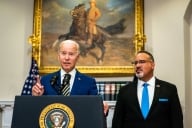You have /5 articles left.
Sign up for a free account or log in.
Pearson will spend the next five years developing a framework to measure and publicly report its products’ efficacy and impact on learning outcomes, the education giant announced on Friday. Although its road map is incomplete today, Pearson says its push for efficacy will in in a few years permeate every way in which the company does business.
Beginning in 2018, Pearson will publish a report that will eventually track student learning outcomes across all its markets and products -- from its MyMathLab software to its investments in South African higher education. How the company will reach that goal, however, is less clear.
Pearson CEO John Fallon acknowledged that Friday’s announcement represents “Efficacy 1.0.” He said the first reports may only cover some of Pearson’s investments, as the company explores how it will measure the effects of its $8 billion enterprise. "We’re saying it will take us a few years to get there, but to make a commitment that, within five years, we will be reporting in a externally auditable way on the impact we have on learning outcomes around the world in as rigorous a way as we report on our financial performance is a profound commitment,” CEO John Fallon said.
Higher education consultants commended Pearson for making efficacy a core concept of its restructuring process. The company is in the middle of a $225 million reorganization to target digital learning and emerging markets.
“At face value, it’s a bold move because it moves the content of education from being critically reviewed by experts to an empirical review,” said Kenneth C. Green, founding director of the Campus Computing Project. “It’s the transition from, 'This is a great book’ to ‘This material really works.’ ”
Pearson will assemble a “global research network” to aid with its Big Data offensive, and Fallon said he expects the company will work with partners ranging from schools to international organizations.
“These are going to be a range of external measures and benchmarks,” Fallon said, adding that Pearson will spend the next five years identifying specific metrics. Some data may come from customer reviews or results reported by competitors, he said.
Green said it will be interesting to see the criteria Pearson will use to benchmark its products, but noted that outcomes will also depend upon teacher expertise and student engagement. “That’s only one third of the total equation, and the sum is larger than the parts in this process,” he said.
Internally, Pearson will create senior leadership positions within every part of the organization to ensure the project remains on track. The officials are tasked with not approving any investment worth more than $1 million “unless we have a clear path to efficacy,” Fallon said. Instead of adding another layer of bureaucracy to the decision making process, he said he envisions it as “a highly dynamic, innovative, iterative exercise.”
The policy even extends to legacy products, said Susan Aspey, vice president of media relations.
“We're in the process of reviewing all of our existing products to ensure that we have the evidence and mechanisms in place to measure, track and continuously improve their impact on learning outcomes,” Aspey said in an email. “This process ... has been under way for the last 18 months, and we have conducted more than 100 reviews so far.”
Apart from the two reports released alongside Friday’s announcement, Fallon said the company is not prepared to share a more detailed timeline of how it will roll out the project or report on its findings. “This is a process of continuous improvement,” he said.
A hint of what the efficacy initiative could look like in five years may be gleaned from looking at how Pearson tracks its finances. If the company seeks to follow that model, learning outcomes may resemble its annual report -- a stand-alone website with rich media and downloadable content.
A Pearson spokeswoman was hesitant to provide a direct comparison, however, as the company’s plans will likely shift as they take shape ahead of 2018.
“Five years is potentially a lifetime in the world of educational technology, but unfortunately five years hasn’t always proved a lifetime in education,” Fallon said. “We’ve gone decades without any real improvement in outcomes for too many millions of people around the world. That can’t be allowed to continue, and it has to change.”








